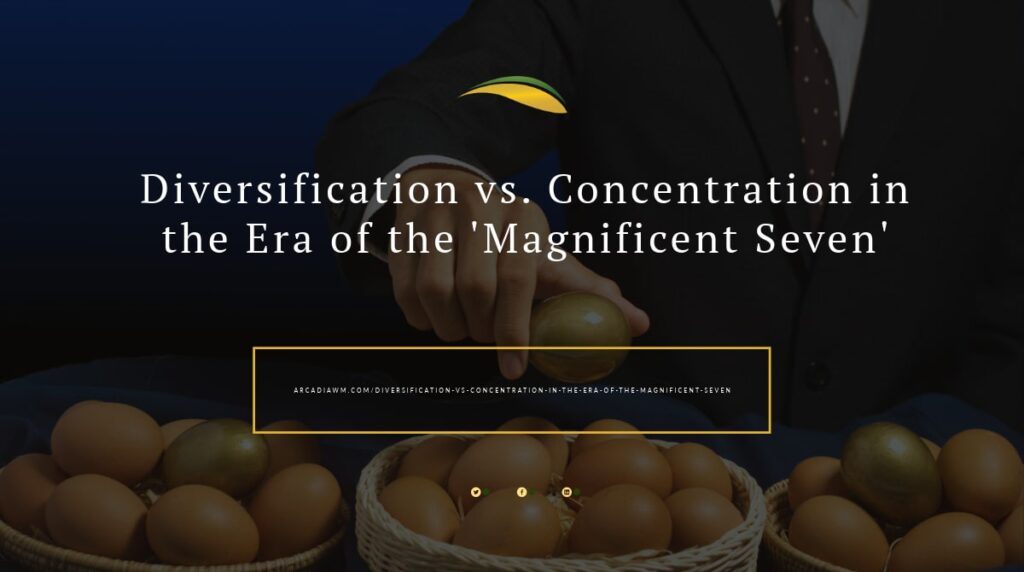At the end of 2022, “The Magnificent Seven” was no more than the title of a 1960 American Western starring Yul Brynner and Steve McQueen. By the end of 2023, however, the “Magnificent Seven” turned into the name of a group of seven stocks that contributed more than two-thirds of the S&P 500® Index’s return that year.1
The Magnificent Seven join the older FAANG stocks in seeming to poke holes in the argument that diversified portfolios, composed of the 500 stocks of the S&P 500 or, better yet, the thousands of stocks composing the total stock market, are best for prudent long-term investors. What’s the point of diversification, ask investors, if seven stocks contribute more than two-thirds of the S&P 500’s return? Shouldn’t we identify, in foresight, at the beginning of each year, the handful of stocks that would be likely winners that year and concentrate our portfolios in them?
The benefits of diversification are obvious to me, as a teacher of finance, and to you, as a financial adviser. I teach these benefits to my students as you teach them to your clients. By the end of the course, I find that most of my students comprehend the benefits of diversification and adopt diversification as an essential part of their investment program. You likely find the same thing among your clients. Yet my students and probably your clients are jolted whenever the returns of handfuls of stocks, whether Magnificent Seven or FAANG, contribute most of the return of the stock market, shaking their knowledge-based belief that diversified portfolios are superior to concentrated ones.
These jolts are longstanding. Responding to a Wall Street Journal article I wrote in 2020, a reader said: “Diversification will, of course, mitigate the losses from your bad picks, but it will also strictly limit the rewards from the good picks.”2 Another reader noted that diversification “ensures that your money is never concentrated in the best-performing assets but diluted in lower-performing assets.” Concentrating a portfolio in the best-performing assets, however, is easier in hindsight than in foresight. Investors who aim to concentrate their portfolios in the best-performing assets might find, too late, that they have concentrated their portfolios in the worst-performing assets.
Yet hindsight errors are pervasive, as displayed by another reader of my Wall Street Journal article: “Look at it this way. Start with 10 funds to choose from” and “weed out at least half of the managers as poor performers … Now select the ‘average’ from among those left … and you’ll end up in the top quartile and beat the market.”
But another reader countered: “Do you drive your car by looking through the windshield or the rear-view mirror?”
The Benefits of Portfolio Diversification
I teach an investments course over 10-week quarters, combining standard and behavioral finance. I describe how rational people make financial choices and how to avoid the cognitive and emotional errors that may hamper normal investors. I describe standard mean-variance portfolio theory but also behavioral portfolio theory, standard asset pricing and behavioral asset pricing.
The course includes a sophisticated investment simulation program that complements lectures and readings, allowing each student to use $1 million to build portfolios of stocks, bonds, mutual funds and exchange-traded funds (ETFs) as they choose and to trade as they wish. It even allows them to buy and trade cryptocurrencies. I use my $1 million to buy and hold a low-cost fund that includes the entire U.S. stock market.
It’s a fair simulation, I tell my students. Like them, I don’t know what will happen in financial markets during the coming 10 weeks of the course. They will learn many lessons from their simulated portfolio but also from their classmates’ portfolios and my portfolio. The program ranks portfolios by their returns, the Sharpe Ratio and alpha, adjusting returns for risk. I tell my students that my portfolio is likely more diversified than theirs and, therefore, less risky, potentially giving my portfolio a ranking advantage. I quickly add that diversification would prevent my portfolio from being the top one. That’s the bad news. The good news is that it would also prevent my portfolio from being the bottom one.
Students participate in discussions with classmates and me, sharing the lessons they have learned. By the end of the course, they typically mention the benefits of diversification as their most important lesson. They also note their surprise at the large role of luck in the outcomes of their portfolios. Some stocks they thought would do well performed poorly, and some they thought would do poorly performed well. Some stocks chosen after careful analysis did well, but others performed poorly, and some chosen at random did well, but others performed poorly. Most students learn the lessons of diversification well. Indeed, when I meet my students years later, they mention the benefits of diversification and tell me that they have prospered by applying the lessons of my course to their portfolios.
Yet, there are always students who resist the lessons of diversification. They want to know the investment strategies of those at the top of the rankings, believing that investment skills matter much in portfolio success, even during 10 weeks, and that luck matters little. One of my students last quarter is a devotee of cryptocurrencies, having allocated most of his portfolio to them. Cryptocurrencies did well during the quarter, placing him high on the portfolio rankings. I probably failed to persuade him that luck plays a role in cryptocurrencies’ quarterly ups and downs.
Navigating Risks: The Magnificent Seven, Diversification and Long-Term Success
This brings me back to the Magnificent Seven, the tech stocks that seem to have highly benefited from the recognition of the potential of artificial intelligence in 2023. It’s normal to believe that we could have known in foresight at the end of 2022 that the Magnificent Seven of 2023 would be magnificent, but that belief is wrong, reflecting hindsight errors.
Indeed, the top 10 stocks of 2022 were all those of energy companies. Moreover, three of the Magnificent Seven show substantial losses when combining the returns of 2022 and 2023, and one shows a small loss.3 Much of the benefit of diversification comes from the fact that the overall positive returns of stocks come from a few winners. Indeed, the returns of most stocks lag those of the U.S. Treasury bill.4 Moreover, the identities of the winning stocks vary over time, with technology stocks in 2023 and energy stocks in 2022.
A portfolio diversified among all stocks, technology, energy, and all other industries would likely include the winning stocks, even if their identities were unknown in foresight. A concentrated portfolio would likely miss them. A portfolio concentrated in technology in 2023 and energy in 2022 would have made investors winners, but a portfolio concentrated in energy in 2023 and technology in 2022 would have made them losers.
Wise investors holding diversified portfolios are likely to do well over the long run, even if not over the short run. However, investors holding concentrated portfolios are likely to do poorly over the long run, even if they do well over many short runs.
Endnotes
-
Matt Krantz, “3 of the ‘Magnificent’ Seven Are Actually ‘Devastating’ Losers,” Investor’s Business Daily, December 15, 2023.
-
Meir Statman, “Investors Still Believe They Can Beat the Stock Market,” Wall Street Journal, September 7, 2020.
-
Krantz, Investor’s Business Daily.
-
Hendrik (Hank) Bessembinder, “Wealth Creation in the U.S. Public Stock Markets 1926 to 2019,” February 13, 2020. Available at SSRN.
Download a PDF of this article
Download the February 2024 Market Review
This article was provided by Avantis Investors and we have been given permission to share this information with our clients and potential clients.






